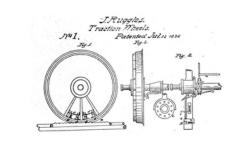The new year of 1836, that is. 1836 was big for the U.S. patent system. It’s the year that the USPTO switched to the current patent numbering system, the year the USPTO started actually examining patent applications, and the year the patent office burned down – in that order.
A little background – the Federal government has issued patents since 1790, when George Washington signed the first one on July 13 (to Samuel Hopkins for a method of making potash). Before that, individual states issued patent-like exclusive franchises, many of them to Oliver Evans, a Philadelphia and Delaware-based 18th-century inventor and entrepreneur, who was a bit like Elon Musk with a smaller megaphone. In fact, Oliver Evans received the third U.S. Federal patent issued and was quite litigious – he brought four of the Supreme Court’s first six patent cases, but that’s a story for another time. In Oliver Evans’ day, there were no ‘patent examiners,’ and patent applications were not ‘examined.’ Instead, the inventor registered his invention with the patent office, even if the invention was copied from an earlier patent. Any questions about enforcement were deferred to the courts.
The USPTO form and function assumed something a bit more like its modern appearance in 1836 with the passage of a new patent act, including moving to the modern numbering system and actually examining applications. Patent 000001, the first under the new system, was issued on July 13, 1836, to U.S. Senator from Maine, John Ruggles, one of the forces behind the new patent act. His invention addressed the problem of traction railroad engines climbing slippery grades. Patent 000001 even looks like a modern patent, with the text typeset rather than hand-written script, and with drawings. The patent office hired its first actual patent examiner (starting work in 1837), and then another to handle the increased load.
But in the meantime – disaster. The patent office and the post office were located in the Blodgett’s Hotel building in Washington.

In the early morning hours of December 15, 1836, the post office’s hot ash came in contact with the patent office’s wood supply with the expected results. In 20 minutes, it was all over. The Blodgett’s Hotel building was gone, with all of its contents, including the 9,957 Federal patents issued from 1790 forward and some 7000 patent models. Arson was suspected, due to ongoing corruption investigations at the post office. The few patents available to us from before the fire were collected from the patent holders.
Congress immediately authorized an impressive fire-proof building, and construction started in 1837. Of course, the new fire-proof building burned in 1871.

Note that this newsletter is written entirely by hand, by human beings, in cuneiform pressed into moist clay. Part of the preceding statement is true; namely, the human being part.
— Robert Yarbrough, Esq.


